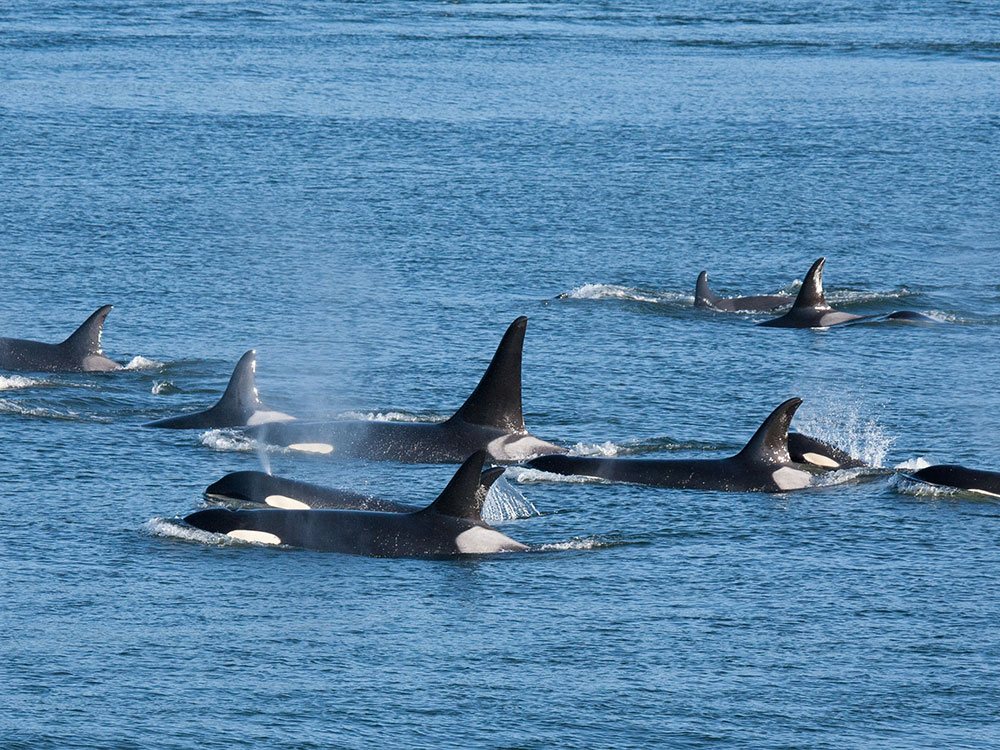The population of Canada’s southern resident killer whales in the Salish Sea off British Columbia has been declining for over 30 years.
Sightings of thin killer whales have led researchers to assign much of the blame for their decline on a shortage of the killer whales’ preferred prey — Chinook salmon.
But the issue is not so black and white.
My recently published paper found that food quality, not just quantity, matters when it comes to the health and survival of these whales.
Not all salmon are the same
Southern resident killer whales are critically endangered due to a medley of issues such as noise pollution, contaminants and low genetic diversity. Yet, their decline has been most closely linked with a concurrent decline in the abundance of their Chinook salmon prey.
However, killer whales prey on many distinct populations or stocks of Chinook salmon, not all of which are in decline. And this discrepancy begs the question of whether all Chinook salmon are equally nutritious as prey.
Previous research on killer whale energetics — studies that estimate how many calories whales burn and how much food they need — had operated under the assumption that all Chinook were created equal.
But if there are major differences in the energy density of different Chinook stocks, previous estimates of the number of salmon required by the killer whales could be off by thousands of fish.
Types of Chinook salmon
Chinook salmon are critical prey for the southern resident killer whales due to their large size, year-round availability and high fat, or lipid content.
Chinook salmon accumulate the highest lipid levels of any Pacific salmon species. This high lipid content leads to a high energy density and makes the salmon a high-quality food source.
However, not all Chinook salmon are the same. Their life history varies from fish to fish. Some enter freshwater in the spring, migrate hundreds of kilometres and climb hundreds of meters in altitude to reach their spawning grounds, while others spawn close to sea level in the fall, less than 50 kilometres from the sea.
These differences demand different levels of stored energy from the salmon and have been believed to drive differences in energy accumulation between the populations.
For species, like the southern resident killer whale, that rely on Chinook, the difference in the total calories offered by the different stocks can be extreme. Some research suggests that certain Chinook populations offer half the calories afforded by others.
The fat of the matter
My supervisor Brian Hunt and I decided to set out and measure the lipid content of Chinook salmon returning to the Fraser River in British Columbia.
The aquaculture industry commonly uses a hand-held fat meter device to measure lipid content in fish fillets. We calibrated one of these fat meters to provide a more ecologically relevant measure of whole-body lipid content.
We then used the device to measure the energy content on individuals from every major Chinook population from the Fraser.
Through this process, We were able to classify Chinook salmon populations into three categories: a low, medium and high lipid group. The differences between these categories were primarily driven by the distance and elevation of spawning grounds from the ocean.
Counting calories
Our data showed that spring Chinook have nearly 70 per cent more lipid and 30 per cent more calories than fall Chinook.
This means that, to meet their energy needs, the southern resident killer whale population would need to eat 325,000 fall Chinook salmon over the year if they only ate this category of salmon. If they only ate high-lipid spring salmon, they would require 245,000 salmon to meet their energy needs, a difference of 80,000 Chinook.
Like these whales, the energy-rich spring Chinook are themselves endangered. As these Chinook populations have dropped, the killer whales have steadily been losing access to some of their richest prey sources.
Fewer high-fat Chinook does not only mean that more salmon are required as prey. As the whales go in search of more prey, the increase in foraging effort also means that more energy is spent looking for food.
What’s worse? Many fall fish contain high levels of persistent pollutants, resulting in killer whales ingesting more contaminants.
Can oceans affect salmon energy?
The lipid content in Chinook salmon has major implications for both the killer whales that rely on the calories it offers and the salmon that need these energy reserves to return to freshwater and spawn.
Understanding the variation in the lipid content of different salmon using tools like the fat meter to assess the quality of the salmon can help improve management of both the southern resident and Chinook populations.
Fish hatchery production or enhancement measures could consider the energy density of salmon to ensure that resource managers are supporting high-quality Chinook and not flooding the environment with low-energy stocks.
Our research provides some of the clearest indications of how the elevation and distance of the spawning ground from the sea impacts the Chinook lipid content. But, we have yet to explore how ocean conditions influence the accumulation of marine energy.
Moving forward, it is crucial to understand how changing ocean conditions may impact salmon lipid accumulation, as this will affect both the Chinook salmon and the killer whales that depend on them.![]()
![]()
Read more: Science + Tech, Environment















Tyee Commenting Guidelines
Comments that violate guidelines risk being deleted, and violations may result in a temporary or permanent user ban. Maintain the spirit of good conversation to stay in the discussion and be patient with moderators. Comments are reviewed regularly but not in real time.
Do:
Do not: